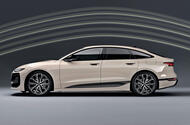The A6 e-tron is Audi's most aerodynamically efficient car ever, with a 0.21Cd
The new A6 E-tron is not just Audi’s most aerodynamically efficient car yet but also one of the sleekest cars on the market – and that is crucial to its headline range figure of 466 miles.
The Sportback’s drag coefficient of 0.21 puts it on a par with the Hyundai Ioniq 6 and just below the Tesla Model S and Mercedes EQS, and it is a bellwether for a new era of range-chasing design and engineering at Audi.
Moni Islam, Audi’s head of aerodynamic and aeroacoustic development, said the A6 E-tron “establishes a new milestone in aerodynamics†for the firm, following in the footsteps of previous streamlined efforts such as the Auto Union Type C, NSU Ro 80, Audi A2 and Mk3 Audi 100, which was the most aero-efficient car of its time. “Vehicle aerodynamics has had kind of a renaissance in the last few years because of vehicle electrification,†said Islam.
He explained that around 40% of a car’s energy can be expended in overcoming air resistance – and it rises to nearer 60% at motorway speeds.
This is particularly pertinent with electric vehicles, where “you are using a third of the contents of the battery to overcome wind resistanceâ€. However, he said EVs open up new opportunities to overcome this physical barrier.
“In the case of a vehicle with a combustion powertrain, we know they have a much lower thermal efficiency than electric powertrains,†said Islam, “so of the fuel that you have in the tank, a large proportion is expended in heat and only 10% of this energy can be actually used for overcoming the aerodynamic drag.
“So the difference in efficiency of the two powertrains is essential in emphasising the importance of aerodynamics.†Islam also highlighted that an EV traditionally has a completely flat floor that is relatively easy to optimise aerodynamically, whereas many components on an ICE car must be left exposed for cooling purposes, limiting what can be done to direct airflow.
This is why Islam and his team have been involved from the outset in the development of Audi’s new PPE platform – used by the A6 and Q6 E-tron – working with designers and engineers to maximise the efficiency of the cars using it.
Active shutters
When the radiator does not need cooling, front grille flaps shut to send air over and beneath the car to add more than seven miles of range.
Air curtain
Air channels in the front wings “bring the flow in a very efficient and controlled manner around this sharp corner and make sure that it interacts optimally with the wheelsâ€.
Wheels
Wheel aerodynamics are “not necessarily intuitiveâ€, said Islam, and a featureless flat disc would not be the optimal design. The A6’s are designed to maximise cooling for the brakes and to “unblock†part of the flow from under the body.
Virtual mirrors
Optional side cameras are so much slimmer than the standard mirrors that they add a claimed 4.3 miles of range. “It’s a technology that we use not only to present attractive and progressive aesthetics but really to improve the vehicle,†said Islam.
Air suspensionÂ
At speeds of more than 75mph, the A6 E-tron drops by 20mm, which both smooths the airflow over the body and brings the body closer to the wheels to reduce turbulence inside the arches.
Hidden Gurneys
Painstakingly modelled Gurney flaps at the rear of the floorpan direct air away from the rear axle, while the rear wheels get their own mini spoilers to create a bubble of still air even at speed.
Q&A: Gernot Dollner, CEO, Audi:
The most aero-efficient cars are low and sleek, but your customers want SUVs. How do you approach that paradox?
“For sure, the concept of an SUV is a burden when it comes to efficiency, but that’s the customer demand: to have SUV cars. By the end of the decade, in the US, 85% of vehicles will be trucks or SUVs, and we also see that trend in Europe. China still likes conventional limousines and flat cars, but we have to look at the world, and on average the SUV is more important.â€
How will your next-generation EVs stand up to technically competitive rivals from China?
“The competition is strong and it’s broader than in the combustion-engine field. For example, in China there are 104 new brands that have come up in the last three years, and we are happy to have that competition.
“We see that our values – like design quality, classical driving functions and especially efficiency and range – are really best in class and so we have no worries when we see that competition. We have a task to do when it comes to in-cabin experience and automated driving, but we are catching up and step by step improving in these fields.â€
The A1 and Q2 will soon be gone for good. Is there a future for Audi below the A3?
“We see a strong future for Audi in the [A3] segment. We’ll see an entry battery-electric vehicle – we just decided [on] one that will be produced in Ingolstadt and it will be at the lower end of that segment.â€

